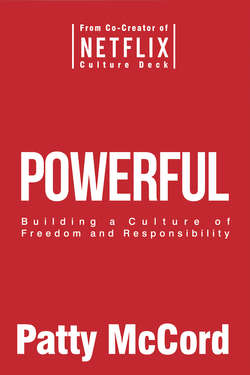Читать книгу Powerful - Patty McCord - Страница 9
The Discipline of Freedom and Responsibility
ОглавлениеDoing away with policies and procedures and giving people agency didn’t at all mean that the culture became a free-for-all. As we stripped away bureaucracy, we coached all of our people, at all levels and on all teams, to be disciplined about a fundamental set of behaviors. I’ve often said that while I’ve removed the words “policy” and “procedure” from my vocabulary, I love discipline. My whole career I have gotten along well with engineers, because engineers are very, very disciplined. When engineers start to whine about a process you’re trying to implement, you want to really dig into what’s bothering them, because they hate senseless bureaucracy and stupid process. But they don’t mind discipline at all.
The most important thing to understand about transforming a culture, whether that of a team or a whole company, is that it isn’t a matter of simply professing a set of values and operating principles. It’s a matter of identifying the behaviors that you would like to see become consistent practices and then instilling the discipline of actually doing them. We fully and consistently communicated to everyone at Netflix the behaviors we expected them to be disciplined about, and that started with the executive team and every manager. We were so intent that every single employee understand our philosophy and the behaviors we wanted them to execute on that Reed started writing a PowerPoint about them, which I and many other members of the management team also contributed to. It ultimately became known as the Netflix Culture Deck. You may have read it.
When Reed posted it on the Web several years ago, he had no idea it would go viral, with more than fifteen million views and counting. We hadn’t created it for broadcast. We created it as an internal company document, using it to communicate the culture to new hires and make sure we were perfectly clear about how we wanted them to operate. We also stressed that it laid out not only what we expected of them but also what they should expect of us. The Deck wasn’t written in one fell swoop and it wasn’t written just by Reed and me. It was a living, breathing, growing, changing set of realizations we came to as we built the culture, with leaders from all around the company making contributions. Reading the Deck would be a great complement to reading this book, and one reason I’ve written this book is that I get so many questions when I speak and in my consulting about the Deck and how to actually enact its concepts.
I’ve thought hard about that, and I have boiled down the lessons we learned about how to instill these principles and behaviors in teams. Not all of the specific practices implemented at Netflix and outlined in the Deck apply to every team or company. Even at Netflix, the culture varied in many respects from department to department. Marketing, for example, was run in many ways that were quite different from the management of the engineering groups. But there was a core set of practices that underpinned the culture:
• We wanted open, clear, and constant communication about the work to be done and the challenges being faced, not only for a manager’s own team but for the company as a whole.
• We wanted people to practice radical honesty: telling one another, and us, the truth in a timely fashion and ideally face to face.
• We wanted people to have strong, fact-based opinions and to debate them avidly and test them rigorously.
• We wanted people to base their actions on what was best for the customer and the company, not on attempts to prove themselves right.
• We wanted hiring managers to take the lead in preparing their teams for the future by making sure they had high performers with the right skills in every position.
We asked all managers, starting at the top with our executive team, to model these behaviors, and by doing so, they showed everyone on their teams how to embrace them as well.
The prospect of getting teams to operate according to these requirements may seem daunting. More than a few Netflixers I’ve talked with as I’ve worked on this book have commented that they were reluctant about one or another of the practices, such as giving totally honest feedback to people face to face. They have also recalled that as they forced themselves to go ahead, they saw how responsive their people were and how dramatically their team’s performance improved. The key is to proceed incrementally. You can start with small steps and then keep building. Pick a practice that you think fits your group and business issues particularly well and start there. For leadership teams, start with one department or group you think is best suited or most in need of change. Creating a culture is an evolutionary process. Think of it as an experimental journey of discovery. That was how we thought about building the culture at Netflix. Which step you start with is no matter; what matters is starting. With the pace of change in business today, there is, as the saying goes, no time like the present.
